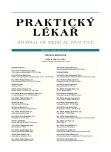Investigation of spine asymmetry in preschool children
Authors:
M. Šlachtová 1; L. Vajčnerová 2
Authors‘ workplace:
Fakulta tělesné kultury Univerzity Palackého, Olomouc, Děkan: doc. PhDr. Zbyněk Svozil, PhD., Katedra fyzioterapie, Vedoucí: prof. MUDr. Jaroslav Opavský, CSc.
1; Centrum léčebné rehabilitace, Olomouc, Vedoucí: MUDr. Alois Deutsch
2
Published in:
Prakt. Lék. 2011; 91(12): 743-746
Category:
Diagnostis
Overview
The diagnosis and treatment of scoliosis are some of the main issues of orthopaedics and physiotherapy. Scoliosis is a very frequent spine deformity in children. It has a detrimental effect on their development and life style. Therefore doctors and physiotherapists attempt to screen for early signs of deformity. The subsequent therapy can at least slow down the scoliosis progression.
The aim of this study was to evaluate the kinesiology analysis in preschool children who had undergone a paediatric check-up at the age of 5 years with normal results in posture. We tried to determine the number of children with the suspicion for scoliosis, scoliotic posture or other posture abnormalities.
We found that 25 % of the sample size of 60 children had positive Adam’s test results and therefore suspicion for scoliosis. The anamnesis questionnaires also showed that the average time spent sitting at a computer is statistically different between the groups with positive and negative Adam’s test results. The results indicate the negative impact of sitting at a computer on the quality of posture in preschool children.
Key words:
scoliosis, preschool children, Adam’s test, posture.
Sources
1. Blaha, J. Idiopatická skolióza – screening, prognostika a konzervativní terapie. Hradec Králové: Gaudeamus, 2005.
2. Cliff, D.P., Okely, A.D., Smith, L.M., McKeen, K. Relationships between fundamental movements skills and measured physical activity in preschool children. Pediatr. Exerc. Sci. 2009, 21, p. 436-449.
3. Doody, M.M., Lonstein, J.E., Stovall, M. et al. Breast cancer mortality after diagnostic radiography. Spine 2000, 25(16), p. 2052-2063.
4. Hromádková, J. a kol. Fyzioterapie. Jinočany: H&H, 2002.
5. Kolář, P. et al. Rehabilitace v klinické praxi. Praha: Galén, 2009.
6. Kouba, V. Motorika dítěte. České Budějovice: Jihočeská univerzita, Pedagogická fakulta, 1995.
7. Kratěnová, J., Žejglicová, K., Malý, M., Filipová, V. Výskyt vadného držení těla u dětí školního věku v ČR. Demografie 2008, 50, 2, s. 144-148.
8. Lewit, K. Manipulační léčba. 5. vyd. Praha: Nakladatelství sdělovací technika, spol. s.r.o., 2003.
9. Novotná, H., Kohlíková, E. Děti s diagnózou skolióza. Praha: Olympia, 2000.
10. Repko, M., Krbec, M., Šprláková-Puková, A. a kol. Zobrazovací metody při vyšetření skoliotických deformit páteře. Ces. Radiol. 2007, 61, 1, s. 74-79.
11. Shangguan, L., Fan, X., Li, M. Inheritance involved in the pathogenesis of idiopathic scoliosis. EXCLI J, 2008, No. 7, p. 104-114. Dostupný na WWW: http://www.excli.de/vol7/lei_shangguan04_ 2008/lei_shangguan22_04_08_proof.pdf
12. Vařeka, I., Vařeková, R. Přehled klinických metod vyšetření stoje a funkčních testů páteře. Olomouc: Univerzita Palackého, 2005.
13. Véle, F. Kineziologie. Praha: Triton, 2006.
14. Vincentová, D. Preventivní prohlídky v pediatrii, role dětské sestry v primární péči. Pediatr. praxi, 2007, 2, s. 116-118.
15. Vlach, O. Léčení deformit páteře. Praha: Avicenum, 1986.
16. Way, L.W. Současná chirurgická diagnostika a léčba. 2. díl. Praha: Grada Publishing, 1998.
Labels
General practitioner for children and adolescents General practitioner for adultsArticle was published in
General Practitioner

2011 Issue 12
- Advances in the Treatment of Myasthenia Gravis on the Horizon
- Metamizole at a Glance and in Practice – Effective Non-Opioid Analgesic for All Ages
- Memantine in Dementia Therapy – Current Findings and Possible Future Applications
- Metamizole in perioperative treatment in children under 14 years – results of a questionnaire survey from practice
- Memantine Eases Daily Life for Patients and Caregivers
Most read in this issue
- Ulcerogenic corticosteroids – the persisting myth among Czech doctors
- Classification of techniques to cope with craving
- Deficit Fluid Volume rating by nurses according to the diagnostic cues of nursing diagnosis
- Interstitial lung diseases in questions and answers
